The Japan Trench Fast Drilling Project (JFAST) drilled three boreholes at Site C0019 to investigate the large shallow slip during the 2011 Tohoku-Oki, Japan earthquake (Mw 9.0). Borehole C0019B, dedicated to logging-while-drilling (LWD), penetrated ~850 meters below seafloor (mbsf) at a water depth of approximately 6890 m, and penetrated through the plate boundary fault zone between the subducting Pacific Plate and the overriding North American Plate. The plate boundary is located at ~820 mbsf and was the likely slip zone during the Tohoku-Oki earthquake. Borehole wall resistivity images obtained from LWD show that drilling-induced borehole breakouts are common in a wide depth range above the fault but are not recorded below the fault. Breakouts are reliable indicators of the orientations of current maximum and minimum horizontal stresses and can also be used to constrain horizontal stress magnitudes. The results of breakout analyses indicate the maximum horizontal stress orientation is highly variable in the upper part of the borehole, but has a clear preferred orientation in a northwest–southeast direction in the deeper part just above the fault. This preferred orientation adjacent to and above the fault is approximately parallel to the direction of the Pacific Plate subduction. Stress magnitude constraint calculations incorporating core data, indicate that the post-earthquake stress states in the hanging wall are either in or close to the normal faulting stress regime.
抄録全体を表示
